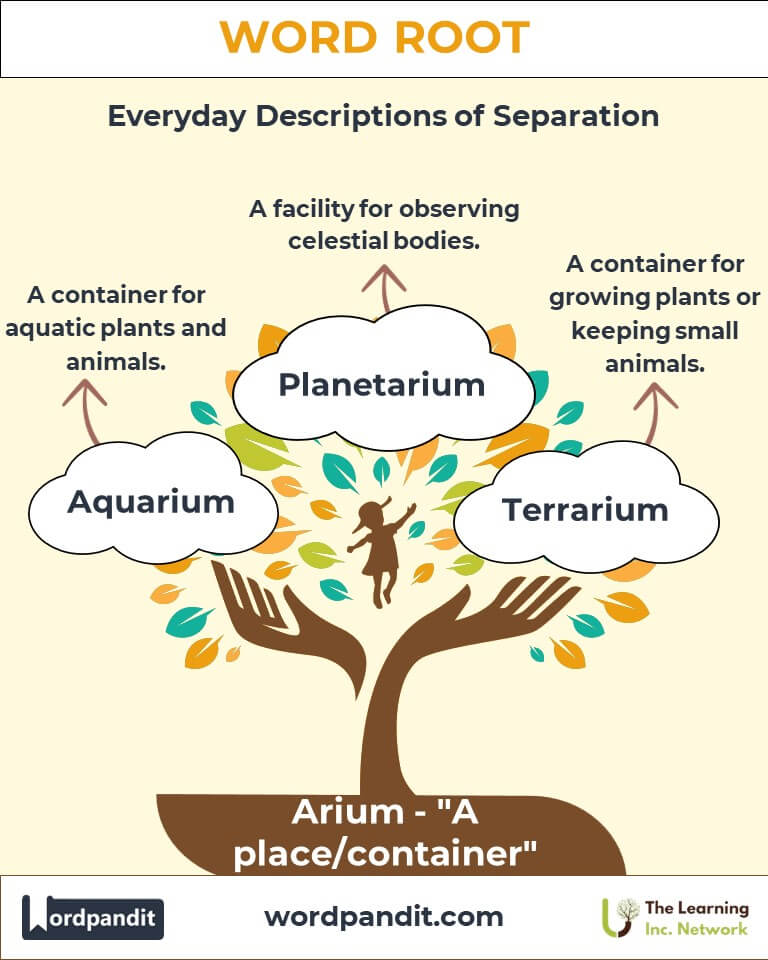Arium: Cultivating Spaces in Language and Life
Byline: Explore the origins, meanings, and applications of the word root "Arium," from ancient Roman structures to modern words signifying specialized spaces. Discover how this root has enriched language by designating environments for growth, study, and preservation.

Table of Contents
- Introduction: Cultivating Spaces in Language
- Etymology and Historical Journey
- Mnemonic: Unlocking the Power of Arium
- Common Arium-Related Terms
- Arium Through Time
- Arium in Specialized Fields
- Illustrative Story: Arium in Action
- Cultural Significance of the Arium Root
- The Arium Family Tree
- FAQs About the Arium Word Root
- Test Your Knowledge: Arium Mastery Quiz
- Conclusion: The Living Legacy of Arium
1. Introduction: Cultivating Spaces in Language
Did you know the word root "Arium" often refers to spaces designed for a specific purpose? Originating from Latin, "Arium" means "place for" or "container." It emphasizes functionality, creating environments for growth, preservation, or study. From "terrarium" to "planetarium," this root connects words describing physical or metaphorical spaces tailored for unique activities. By understanding "Arium," you unlock a linguistic doorway to concepts about space and purpose.

2. Etymology and Historical Journey
"Arium" derives from Latin, where it functioned as a suffix indicating a "place for" something. For example, the Latin "terrarium" means "place for earth," combining terra (earth) and the suffix -arium. The Romans used "Arium" to name spaces like solariums and atriums, which influenced later architectural and linguistic developments.
In medieval times, the use of "Arium" expanded as scholars revived Latin for scientific and scholarly works. This era gave rise to terms like "aquarium" (a place for water) and "sanitarium" (a place for health), bridging practical needs with evolving intellectual pursuits.
3. Mnemonic: Unlocking the Power of Arium
Picture a "terrarium," a glass container nurturing a miniature ecosystem. This vivid image ties "Arium" to the idea of a specialized environment. Here's a helpful mnemonic:
Mnemonic Device: “Arium—A special room for purpose and growth.”
By associating "Arium" with nurturing spaces, you connect its meaning to real-world applications.
4. Common Arium-Related Terms
- Terrarium (ter-RARE-ee-um): A container, often made of glass, for growing plants or keeping small animals.
Example: “The terrarium on her desk added a touch of green to the office.” - Aquarium (uh-KWAIR-ee-um): A tank for aquatic plants and animals.
Example: “The kids loved watching the jellyfish glide in the aquarium.” - Planetarium (plan-uh-TAIR-ee-um): A theater for viewing simulated celestial displays.
Example: “The planetarium show explained the constellations visible this season.” - Vivarium (vih-VAIR-ee-um): An enclosure for keeping and observing live animals or plants.
Example: “The vivarium housed rare reptiles from the Amazon.” - Solarium (so-LAIR-ee-um): A sunlit room designed for relaxation.
Example: “They added a solarium to their house to enjoy winter sunlight.”
5. Arium Through Time
Atrium: Originally, an atrium was a central, open-roofed room in Roman houses, allowing light and air. Today, atriums are spacious, light-filled areas in public buildings.
Sanitarium: This term evolved from describing recovery centers for tuberculosis patients to modern wellness retreats.
6. Arium in Specialized Fields
- Biology: Vivariums are used for controlled biological studies.
Application: Helps researchers observe ecosystems and animal behavior. - Astronomy: Planetariums educate audiences about celestial phenomena.
Modern Impact: Combines entertainment with scientific outreach. - Architecture: Atriums enhance natural lighting in sustainable design.
Example: Public buildings often incorporate atriums for aesthetic and practical benefits. - Environmental Science: Terrariums support environmental education and experiments.
Example: NASA uses terrariums to study plant growth in microgravity.
7. Illustrative Story: Arium in Action
Dr. Aurelia, a biologist, managed a state-of-the-art vivarium replicating rainforest conditions. One day, she noticed unusual behavior in a rare frog species. Using the vivarium’s controlled environment, she identified a new mating ritual, leading to a breakthrough in amphibian studies. Her findings emphasized the vivarium's role in advancing ecological knowledge and conservation.
8. Cultural Significance of the Arium Root
"Arium" reflects humanity’s ingenuity in creating spaces tailored for life and learning. Whether it’s the meditative stillness of a solarium or the cosmic wonders of a planetarium, "Arium" celebrates purposeful design. It also symbolizes our innate drive to observe, nurture, and understand the world.

9. The Arium Family Tree
- Ori (to rise): Originarium - An obsolete term meaning "starting point."
- Aqua (water): Aquarium - A place for aquatic life.
- Viva (alive): Vivarium - A controlled environment for studying living organisms.
FAQs About the Arium Word Root
1. What does "Arium" signify in language?
"Arium" originates from Latin, meaning "a place for" or "a container." It is commonly used as a suffix to denote spaces or environments designated for specific purposes, like aquarium (place for water creatures) or planetarium (place for studying celestial phenomena).
2. Is "Arium" only associated with physical spaces?
While "Arium" primarily refers to physical spaces, it can also denote metaphorical or functional spaces. For instance, a "sanitarium" was historically a retreat for health and recovery, focusing on the concept of well-being rather than just a tangible room.
3. How does "Arium" influence modern scientific language?
In scientific contexts, "Arium" is used to name controlled environments like vivariums for observing living organisms or terrariums for studying ecosystems. These spaces support research and innovation in biology, ecology, and conservation.
4. Why do many architectural terms include "Arium"?
In architecture, "Arium" highlights design elements that create specialized environments. For example, atriums in buildings provide natural light and airflow, demonstrating the term's connection to purpose-driven spaces.
5. What is the cultural significance of "Arium"?
"Arium" symbolizes humanity’s creativity in shaping environments to serve specific needs. From Roman atriums fostering social interaction to modern vivariums advancing ecological research, it reflects our ongoing relationship with space and function.
6. Are all "Arium" words derived directly from Latin?
While many "Arium" words have Latin roots, their widespread adoption in English and other languages often results from scientific terminology rather than direct linguistic inheritance.
7. What are some lesser-known terms that include "Arium"?
Examples include herbarium (a collection of preserved plants) and insectarium (a space for displaying insects), which cater to niche scientific interests.
8. Can "Arium" be combined with modern prefixes or roots?
Absolutely! Contemporary language frequently adapts "Arium" for new contexts, like "bacterium-arium" (a theoretical term for bacterial observation environments) or "data-arium" (a conceptual term for digital storage spaces).
Test Your Knowledge: Arium Mastery Quiz
1. What does "Arium" typically mean?
2. Which field frequently uses "Vivarium"?
3. Which Arium-related space simulates the stars?
4. What was the original use of "Atrium"?
5. What does "Solarium" emphasize?

12. Conclusion: The Living Legacy of Arium
From terrariums nurturing ecosystems to planetariums igniting cosmic curiosity, the root "Arium" has profoundly shaped how we designate purposeful spaces. Its historical depth and linguistic adaptability highlight humanity’s pursuit of knowledge and innovation. As our needs evolve, "Arium" will continue inspiring new words and concepts, illustrating our drive to craft environments that enrich life.











